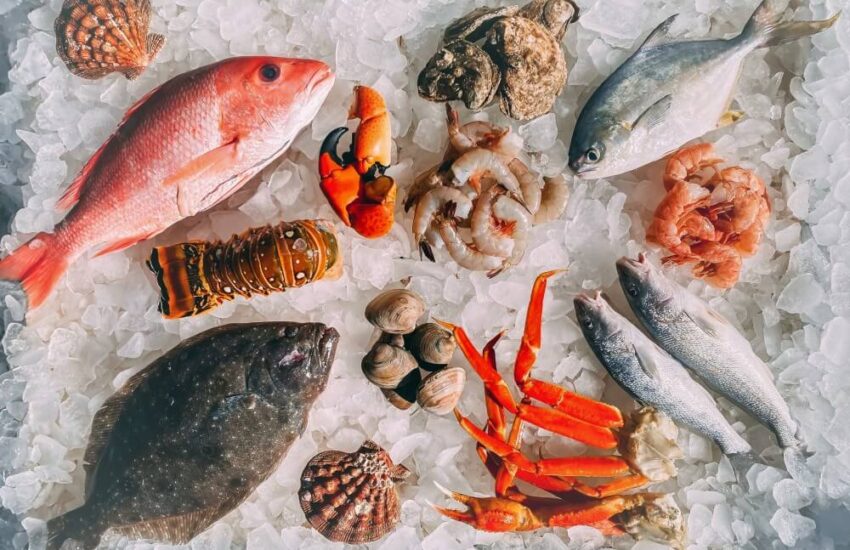Various marine consumables, such as shellfish and ocean fish, are included in the broad definition of seafood. Customers worldwide have easy access to seafood imported from all over the world. Farm-raised and wild-caught seafood are both readily available. Typically farmed fish like catfish and tilapia are used, but wild swordfish, tuna and shark are caught from the ocean. Increased investment in research and development has led to an increase in the number of specialty fish stores and restaurants, which in turn has led to an increase in seafood consumption.
Fish has a far lower carbon footprint than other animal foods, therefore it has a lot of potential for feeding a growing global population in a sustainable way. The Covid-19 pandemic, changing customer preferences, and more climate regulation are all bringing new realities to the food market. Understanding and delivering on customers’ expectations and preferences will be critical to sustaining relevance and generating future growth in today’s competitive marketplace. The fish sector is being impacted by four major consumer trends.
Trends in the Seafood Industry
Growing Consumer Preference
Pescetarianism, which refers to persons who eat a vegetarian diet but exclude red meat, is becoming more popular among non-vegetarians. “Seaganism” is a new trend in veganism that incorporates sustainable seafood into the diet for added protein and occasional meaty treats. Seafood is an important part of a Seagan’s diet because it provides high-quality omega-3 fatty acids, which are difficult to obtain on a standard vegan diet.
There were several lockdown tendencies in the past, but our discovery of frozen and canned fish has proved to be more than simply an anomaly. People’s eating habits haven’t changed much since the peak of the pandemic, according to the data. They’re still relying on staples like tinned tuna and fish fingers. Tuna melts and chunky fish-finger sandwiches were invented by home cooks.
Additionally, a new trend guaranteed to outlive lockdown was taking place in and around our homes. Sales of patio heaters and BBQ grills soared as the global pandemic compelled people to spend more time outside. Chief tong wielders experimented with grilled prawns, squid, and octopus as well as swordfish, sardines, and tuna steaks as alternatives to the traditional bangers and burgers.
Growing Import-Export
Import/export market overdependence can lead to major problems, according to COVID-19. The lockdown caused by the pandemic led to restaurant and hotel closures in the United States, Europe, and China which has severely disrupted the fresh and frozen seafood supply chains of fishermen and aquaculture producers who relied on a single key market for their products.
While many small-scale fisheries and aquaculture enterprises were able to adapt rapidly and weather the storm, others were forced to refocus on the domestic market. It was also encouraging to see governments and businesses working together to protect local fisheries and aquaculture from economic harm.
It is predicted that this trend to continue in the seafood business, even if COVID-19 expedited this growth of import/export markets. To better protect themselves in the case of another market crisis, small-scale fishermen and aquaculture producers should diversify their markets.
Experimentation
Chefs and food pioneers in the seafood business are redefining two meat-industry concepts popular in the previous decade: artisan charcuterie and nose-to-tail eating. Seacuterie and fin-to-gill eating are examples of these in the seafood sector. It was just a matter of time before chefs began to employ all of the fish’s parts because of cost and sustainability concerns. There are no limits to what can be done, and much like offal, the results are typically better than expected. Fish-eye crackers, fried salmon skin oil aioli, and pan-seared halibut cheeks and collars are just a few of the seafood pleasures that we can look forward to seeing more of in the next decade, as chefs look to branch out from the traditional fare of fish-head soup. Some of these recipes require a lot of courage to prepare, so novice home cooks might wish to start with a simple fish bone stock.
Digital Technology for Seafood Sustainability
Many fishermen and aquaculture suppliers found new markets as a result of COVID-19’s upheaval of the import/export sector. It was possible to interact directly with consumers via a digital marketplace if you were quick enough to move your products there. Aside from modernizing fishing and aquaculture operations, digital technology also aids in raising public awareness of sustainable seafood practices. Future developments in digital technology will have a significant impact on the seafood industry, especially when it comes to promoting sustainable fishing practices.
COVID-Impact and Future Ahead
Many small-scale fisherman and aquaculture producers were challenged by COVID-19, but it also provided us with opportunities to construct more robust and sustainable supply networks. After the recent COVID-19 pandemic, the sustainability and resilience of global fish supply networks were reevaluated by businesses and governments alike. Communities and small businesses that depend on artisanal fishing are particularly vulnerable to disruptions like COVID-19. Due to global warming and pollution, sustainable fishing practices have become more important than ever before. Marine ecosystems around the world have become more vulnerable in recent years as consumers become more aware.
The majority of the total culture crop is produced by rising nations, who dominate the fish market as the primary producers. Aquaculture products are processed, produced, exported, and imported in greater quantities than any other country in the globe. The rise of the Chinese market is aided by rising living standards, an increase in the consumption of seafood, a robust export economy, and government regulation that simplifies market infrastructure and offers tax incentives to new businesses.
Local governments and international conservation organizations have made sustainable seafood consumption and the protection of rare and endangered species such as Atlantic halibut, winter skate, and bluefin tuna a primary priority. Environmental issues like global warming, animal welfare, ocean preservation, and environmentally friendly production practices aren’t the only things on customers’ minds these days. Sustainable products with minimal environmental impact are expected by customers.
